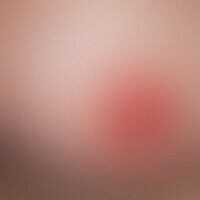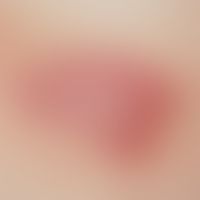Image diagnoses for "Torso"
551 results with 2173 images
Results forTorso

Adverse drug reactions of the skin L27.0
Drug exanthema: Macular, moderately itchy exanthema that occurred 5 days after taking an antibiotic (cephalosporin).

Melanoma superficial spreading C43.L

Dermatitis herpetiformis L13.0
Dermatitis herpetiformis: multiple, disseminated, eminently chronic, itchy, prickly, scratched excoriations, few vesicles (note: the vesicles must be sought in DhD).

Paget's disease of the nipple C50.0

Pemphigus chronicus benignus familiaris Q82.8
Pemphigus chronicus benignus familiaris (detailed picture): multiple, chronically dynamic (changing course), little itchy, sharply defined, red, rough, scaly plaques; margins erosive and crusty in places.

Calcinosis metastatica; calcifying uremic arteriolopathy; metastatic calcinosis E83.5
Calcinosis metastatica: Symmetrical, stelae linearly arranged, moderately painful, hard, skin-coloured papules and plaques.

Fixed drug eruption L27.1
Drug reaction, fixed: suddenly appeared, reddish-brownish, roundish, sharply defined, hardly infiltrated plaques, existing for a few days. 20-year-old female patient. Probably drug-induced cause: paracetamol.

Late syphilis A52.-
Late syphilis: with asymmetrical, reddish-brown, completely symptom-free plaques with crust formation (tubero-serpiginous syphilis).

Angioma serpiginosum L81.7
Angioma serpiginosum. garland-shaped red spots on the upper arm of an 18-year-old woman, existing for several years, completely without symptoms. No mucous membrane infestation.

Mycosis fungoides patch stage C84.0
Mycosis fungoides patch stage. Solitary infestation of the mamma.

Vitiligo (overview) L80
Vitiligo: First appearance 4 years ago of differently sized, differently configured, sharply defined, progressive, differently intensely depigmented patches on the trunk and extremities of a 31-year-old patient with skin type IV.

Lichen sclerosus extragenital L90.0
Lichen sclerosus extragenitaler: large-area lichen sclerosus of the mamma; diffuse, veil-like, only slightly increased sclerosis of the skin; not quite fresh large-area hematoma in lesioned skin. Remark: in the bradytrophic lesions of the LS, bleedings persist for an unusually long time, so that the persistent (gradually blackening hematoma) is the actual reason for a visit to the doctor.

Keratosis areolae mammae naeviformis Q82.5
Keratosis areolae mammae naeviformis: painless nipple-like change of both nipples, existing since puberty.

Meyerson-naevus L30.8
Meyerson's phenomenon: Psoriatic foci around seborrheic keratoses. Meyerson's phenomenon.

Basal cell carcinoma (overview) C44.-
Basal cell carcinoma (overview): Basal cell carcinoma superficial, detailed view.

Eosinophilic pustular folliculitis L73.8
Pustulose, sterile eosinophil. close-up, blurred urticarial erythema with pinhead-sized papulovesicles and pustules in the trunk area.

Acne conglobata L70.1
Acne conglobata:symmetrically distributed, inflammatory papules and pustules with cystic transformation with a tendency to melt down, severe scarring and comedones. Mostly occurring in young people in the facial and upper body region. Chronic, often pressure-painful course.

Atrophodermia idiopathica et progressiva L90.3
Atrophodermia idiopathica et progressiva: slowly progressive, large, brown, non-symptomatic patches

Rowell's syndrome L93.1
Rowell's syndrome: acute "multiform" exanthema in subacute cutaneous lupus erythematosus.

Keratosis seborrhoic (papillomatous type) L82
Keratosis seborrhoeic (papillomatous type): brown nodules with lobed and punched surface. sharp border. slight surface scaling.




